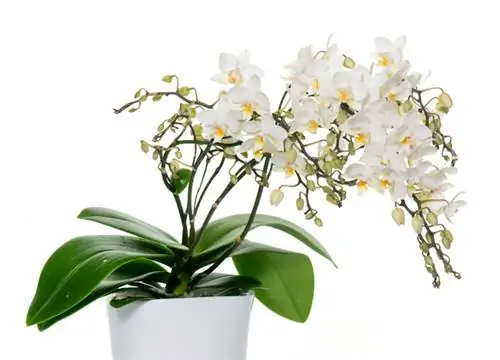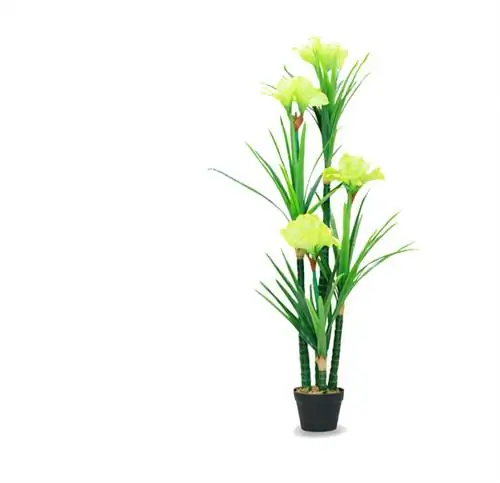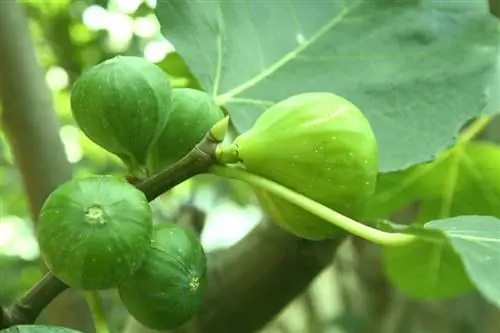- Author admin [email protected].
- Public 2023-12-16 16:46.
- Last modified 2025-06-01 06:02.
The successful care of orchids requires a high level of horticultural sensitivity. Only when all the framework conditions mesh harmoniously do the epiphytic and terrestrial flowers from the tropical rainforests bloom. The adequate fertilizer contributes significantly to the hoped-for flower spectacle. Explore the wide range of suitable fertilizers for your orchids here with practical tips on how to use them.

What nutrients should the fertilizer contain and how often should I fertilize orchids?
To ideally fertilize orchids, the fertilizer should contain nitrogen, phosphorus, potassium, calcium and magnesium. Liquid fertilizer is particularly suitable because it can be dosed precisely. Fertilize your orchids every two weeks during the growth and flowering period.
Which nutrients should a priori be contained in orchid fertilizer?
Orchids mostly thrive epiphytically. They cling to the branches of mighty rainforest trees while their aerial roots extract the vital nutrients from the rain or blown-up leaves. A good orchid fertilizer should have these main components:
- Nitrogen (N): Promotes the growth of leaves and shoots
- Phosphorus (P): Promotes flower formation and contributes to he althy root growth
- Potassium (K): Optimizes resistance by supporting metabolism in orchids
- Calcium (Ca): Important trace element that stimulates growth and cell reproduction
- Magnesium (Mg): As a trace element, it ensures, among other things, a rich green leaf color
The magnificent flowers are naturally more attuned to a nutrient diaspora. The sensitive roots cannot tolerate the concentrated load of conventional flower fertilizers, and the high s alt concentration is particularly difficult for them. Therefore, explore suitable fertilizers below that take the unorthodox habitus into account.
Liquid fertilizers for orchids score with numerous advantages
Orchid fertilizer in liquid form impresses with a special composition that is precisely tailored to the needs of demanding plants from tropical and subtropical regions. Furthermore, precise dosage is possible, taking into account factors such as the type of orchid, age of the plant or the season. How to use the fertilizer correctly:
- Add to watering or dipping water every 2 weeks during the growing and flowering period
- Never apply liquid fertilizer directly to the substrate or roots
- Do not fertilize orchids during the dormant phase
If the orchid soil has dried out, please water it with clear water first and only then add the liquid fertilizer. For young plants or freshly purchased orchids, we recommend first halving the dosage specified by the manufacturer.
Sticks as orchid fertilizer are not always the ultimate option
Fertilizers in stick form are very popular in the care of houseplants. Pressed into the substrate in adequate numbers, the plant is well supplied with all nutrients for the next 3 months. That saves time and money. However, experts are still critical of the effectiveness of this method on orchids. Since the substrate must be moist so that the active ingredients are distributed, this requirement is not always met in coarse, porous orchid soil. Furthermore, there can be a concentrated release of nutrients at certain points, while root strands further away are left empty-handed.
Foliar fertilization - care and fertilization in one go
Native to the warm, humid climate of tropical rainforests, orchids only thrive under the influence of high humidity of 50 to 80 percent. At the same time, the noble flowers react extremely badly to waterlogging and, in the worst case, die due to root rot. With these premises in mind, resourceful experts have developed a vital spray for foliar fertilization especially for orchids.
Thanks to a low-s alt formula and equipped with all important nutrients in an NPK formulation of 0, 1-0, 25-0, 25, the orchid absorbs moisture and fertilizer through its leaves and aerial roots. Foliar fertilization is an excellent alternative, especially for orchids cultivated without a substrate, such as Vanda. This is how you use the product correctly:
- Pour the liquid fertilizer into a hand sprayer with lime-free water according to the specified dosage
- Spray on the top and bottom of the leaves and roots all year round
- Do not apply foliar fertilization under direct sunlight
- Do not spray flowers
Homeopathic fertilizer - ideal for ecologically oriented orchid gardeners
Organic fertilizers, such as horn shavings, compost or guano granules, are unsuitable for supplying orchids with nutrients. The materials must first be processed by soil organisms so that they are available to the roots. As an environmentally conscious hobby gardener, you can still stay true to your style when it comes to orchid care.
Various manufacturers offer homeopathic fertilizer sprays as ready-to-use strengthening agents for your orchids. It contains only natural components, such as worm humus, horsetail extract, guano or copper sulfate. Used regularly during the growth and flowering period, flower formation is activated, leaf growth is promoted and resistance is strengthened.
Soil orchids happily accept compost and horn shavings
For your hardy terrestrial orchids in the garden, no complex pull-ups are required when it comes to nutrient supply. These robust orchid species, such as orchids or lady's slipper, gratefully accept ripe leaf compost and horn shavings as starter fertilizer in spring. In late summer, potassium-rich comfrey manure strengthens winter hardiness.
Tip
Regardless of which fertilizer you prefer for your orchids, you can still optimize its effectiveness. The plant aid 'Root Complex (€24.00 at Amazon)' from Hesi improves the absorption of the active ingredients without containing fertilizer or increasing the s alt content. Administered before and after repotting, the preparation also reduces the stress on your sensitive orchids.






